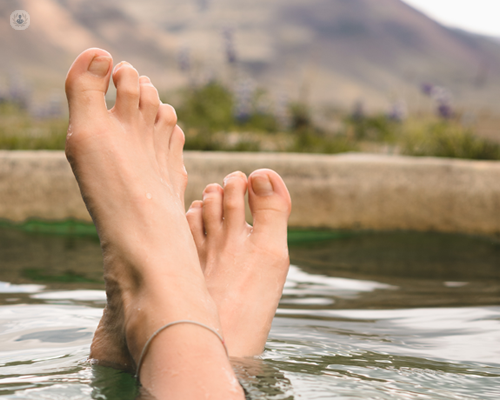Happy feet: The ultimate guide to preventing common foot problems
Escrito por:We take a look at ways to prevent common foot problems in this informative article.

What are the most common foot problems?
Foot problems can range from mild discomfort to severe pain, and they can affect your mobility and quality of life. The most common issues include:
- Bunions: A bony bump that forms on the joint at the base of the big toe, often caused by wearing tight, narrow shoes.
- Plantar fasciitis: Inflammation of the thick band of tissue that runs across the bottom of the foot, leading to heel pain.
- Corns and calluses: Thickened skin that forms in response to pressure or friction, typically on the toes or soles.
- Athlete’s foot: A fungal infection that causes itching, redness and cracked skin, usually between the toes.
- Ingrown toenails: Occur when the edges of the nail grow into the surrounding skin, causing pain and sometimes infection.
How can I prevent these foot problems?
Taking good care of your feet is essential in preventing common foot conditions. Here are some tips to keep your feet healthy:
- Wear proper footwear: Choose shoes that fit well, offer good arch support, and have enough room for your toes. Avoid wearing high heels or tight shoes for long periods.
- Keep your feet clean and dry: Wash your feet daily and dry them thoroughly, especially between the toes, to prevent fungal infections like athlete’s foot.
- Moisturise regularly: Apply moisturiser to prevent dry, cracked skin, but avoid putting it between the toes, where moisture can lead to fungal infections.
- Trim your toenails properly: Cut your nails straight across and avoid trimming them too short to prevent ingrown toenails.
- Avoid walking barefoot in public areas: Places like swimming pools and gym showers can be breeding grounds for fungal infections.
What is the best way to manage foot pain?
If you’re already experiencing foot pain, there are several methods you can try for relief:
- Rest and ice: Giving your feet a break and applying ice to the affected area can reduce inflammation and pain.
- Over-the-counter pain relief: Medications like ibuprofen or paracetamol can help ease discomfort.
- Footwear adjustments: Switch to more supportive shoes or use orthotic insoles to alleviate pain from conditions like plantar fasciitis or bunions.
- Stretching exercises: Stretching the calf muscles and plantar fascia can improve flexibility and relieve tension in the feet.
When should I see a specialist for foot problems?
While many foot issues can be managed at home, it’s important to see a podiatrist or orthopaedic specialist if:
- Your pain persists despite home treatments.
- You notice swelling, redness or warmth, which could indicate an infection.
- You have diabetes and develop any foot issues, as complications can escalate quickly.
- You experience recurring foot problems like corns, calluses or ingrown toenails.
By following these preventive measures and seeking timely medical advice when needed, you can keep your feet healthy and avoid the discomfort caused by common foot conditions.


